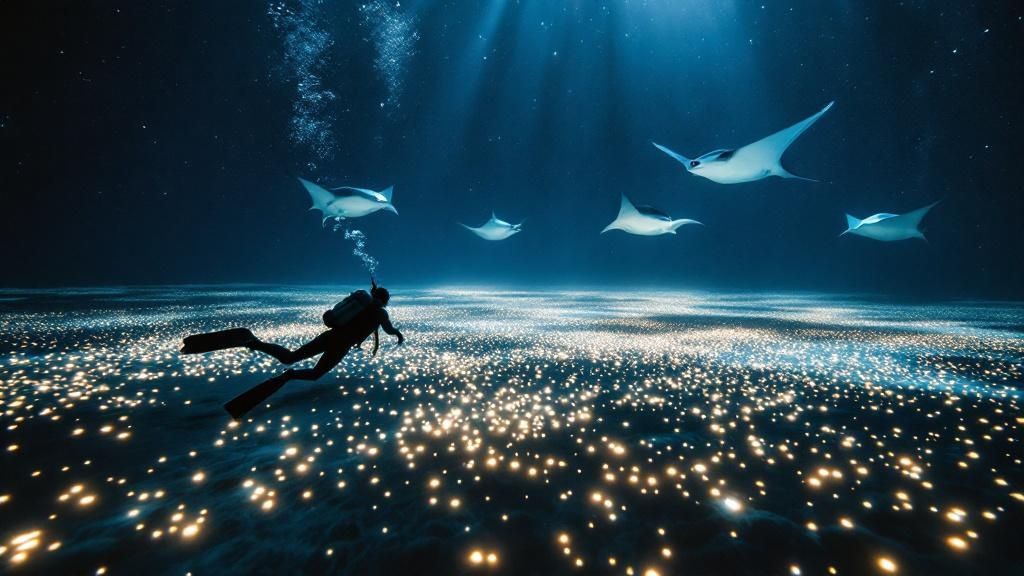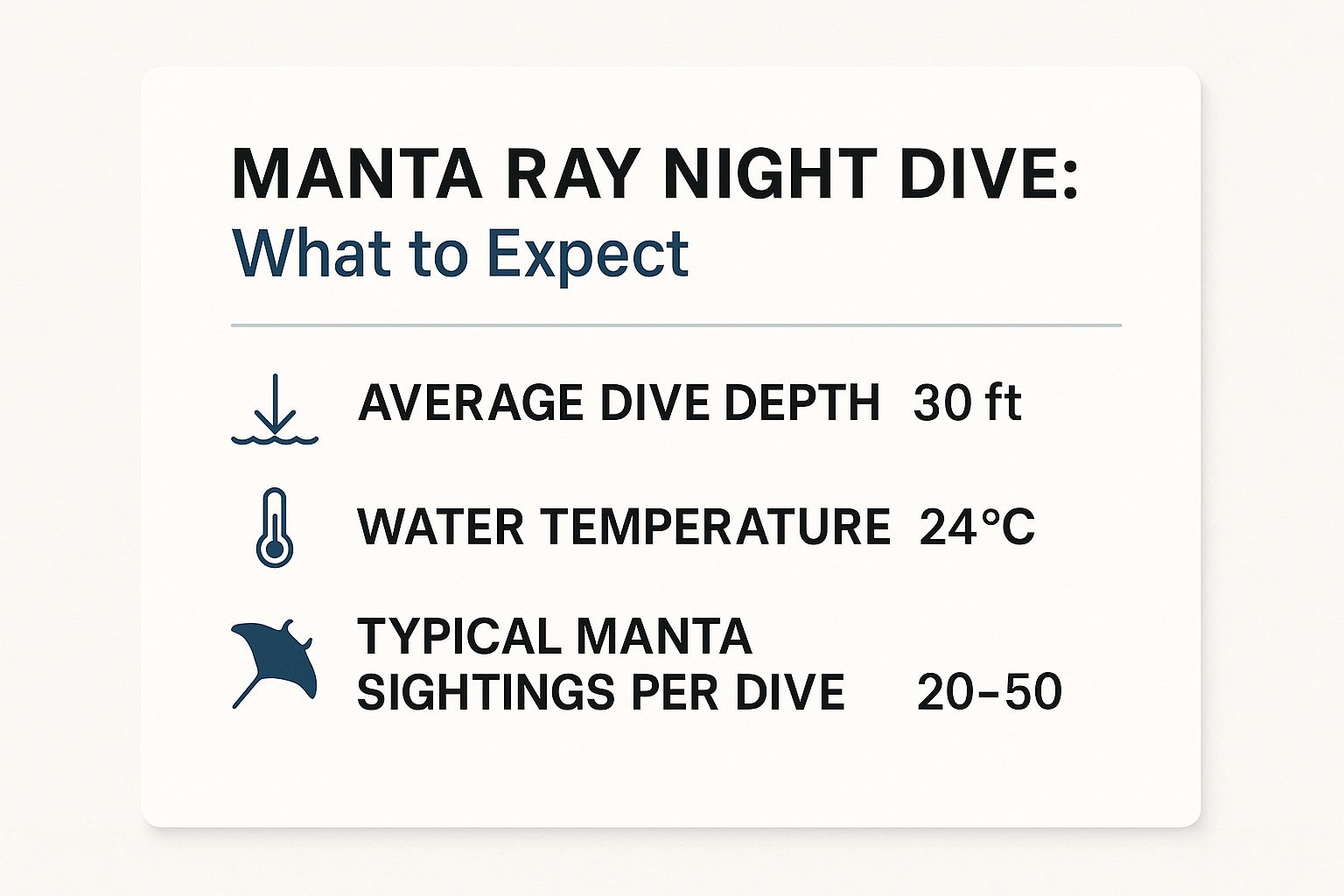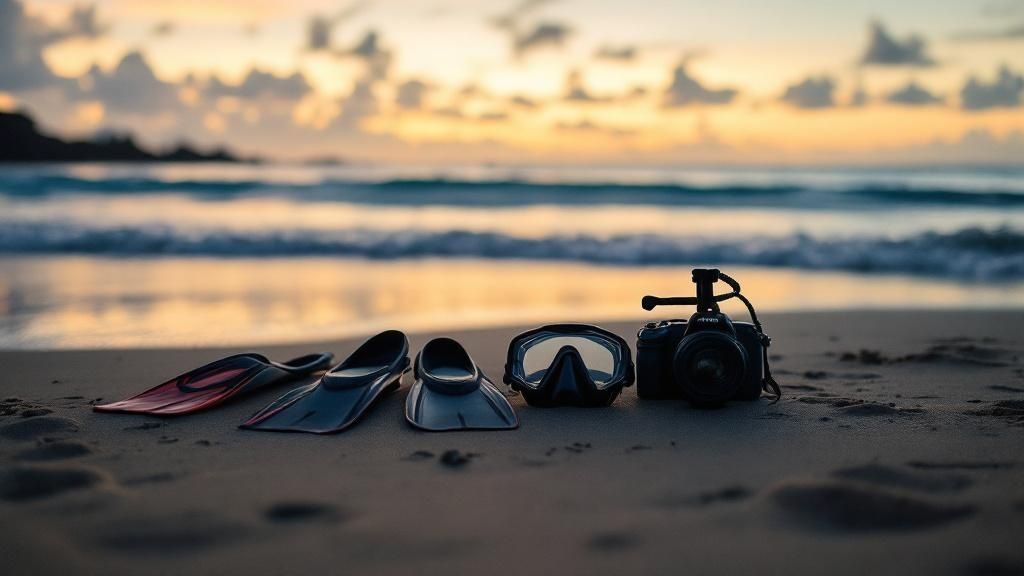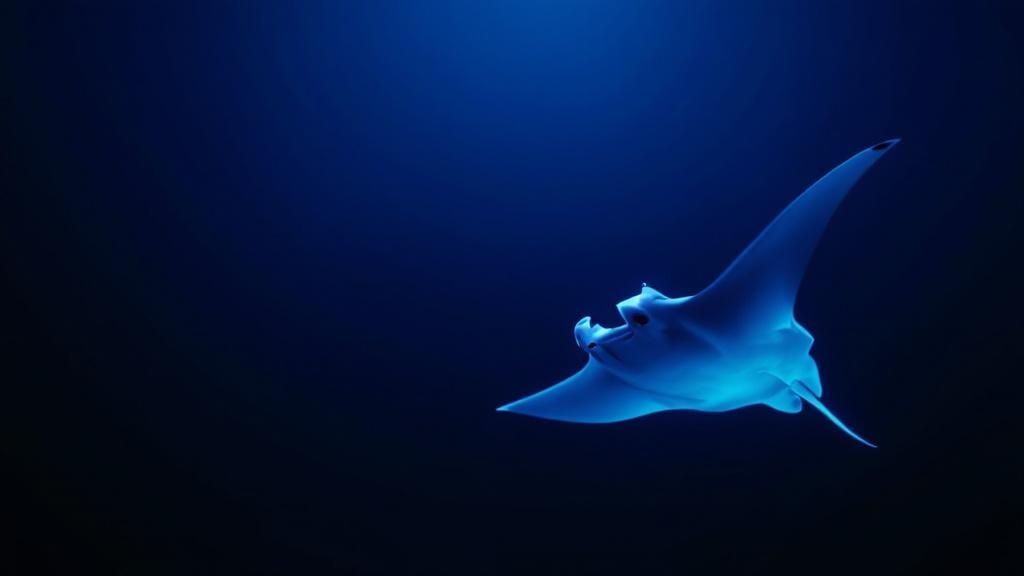Why Kona Waters Create The Ultimate Manta Ray Experience
Kailua Kona, Hawaii, isn't just a beautiful island destination; it's a world-renowned sanctuary for manta rays. Divers and snorkelers flock here, hoping for a magical encounter with these gentle giants. This isn't a coincidence. The region's unique geology and ocean conditions create the perfect habitat for these graceful creatures, making "manta ray night dive kailua kona" a highly sought-after adventure.

The Volcanic Advantage
The volcanic coastline of Kailua Kona plays a crucial role in this thriving ecosystem. Volcanic activity releases vital nutrients into the ocean, supporting the growth of massive plankton blooms. These blooms are the manta rays' primary food source, drawing them to these nutrient-rich waters. The volcanic rock formations also offer shelter and cleaning stations for the mantas, supporting a healthy and flourishing population.
Perfect Underwater Topography
The underwater topography of Kailua Kona is perfectly suited for manta ray feeding. Lava tubes and coral formations create channels and funnels that concentrate plankton. This makes feeding easier for the mantas. This reliable food source attracts mantas to known feeding grounds, such as Manta Village and Manta Heaven, night after night.
This predictability makes Kailua Kona an excellent location for viewing manta rays. Divers and snorkelers have an 85-90% chance of encountering these majestic creatures during night dives. This high success rate is thanks to the unique underwater environment and the abundance of plankton, attracting mantas to these specific locations. For more information and statistics, visit Manta Ray Dive Kona.
Optimal Water Conditions
Water temperature, clarity, and currents all play a key role in the manta ray experience. Kona's consistently warm waters are comfortable for both mantas and divers. The exceptional water clarity provides incredible visibility, allowing for stunning views of these creatures. While currents can vary, they often contribute to the concentration of plankton, further improving feeding opportunities for the mantas.
Other Marine Encounters
If you enjoy underwater adventures, consider other marine wildlife experiences like whale watching. The rich biodiversity of Hawaiian waters provides a wealth of opportunities to observe marine life in its natural habitat. The combination of volcanic activity, unique underwater topography, and optimal water conditions establishes Kailua Kona as a premier destination for a manta ray night dive. It's a truly memorable experience showcasing the wonder and beauty of these ocean giants.
Manta Village Vs Manta Heaven: Choosing Your Perfect Dive Site
Kailua Kona offers two exceptional locations for manta ray night dives: Manta Village and Manta Heaven. Both offer incredible opportunities to witness these gentle giants feeding, but each has unique characteristics suited to different divers. Choosing the right site for your experience and expectations is key to maximizing your manta ray night dive Kailua Kona adventure.
Manta Village: The Beginner-Friendly Option
Manta Village, located south of Kona near the Sheraton Keauhou Bay Resort & Spa, is known for its calm, shallow waters, making it perfect for beginners. The average depth is around 30 feet with generally calm conditions. This site boasts a remarkably high manta ray sighting rate, often over 90%. This makes it an excellent choice for first-time manta ray divers or those less experienced in open water. The sandy bottom provides a stable platform to observe the manta rays feeding above.
Manta Heaven: The Thrill-Seeker's Paradise
North of Kona, off the coast of the Kona International Airport, lies Manta Heaven, also known as Garden Eel Cove. While its sighting rate is slightly lower than Manta Village (around 75-90%), Manta Heaven can offer more dramatic encounters. This is because it typically attracts larger numbers of manta rays per dive, creating a breathtaking spectacle. However, this site is generally better for experienced divers due to the potential for stronger currents. The bottom is more varied, with coral formations and lava rocks adding complexity to the dive.
To help you compare the two sites, here's a table summarizing the key differences:
To help you choose the best dive site for your experience level, we've created this comparison table:
| Feature | Manta Village | Manta Heaven |
|---|---|---|
| Location | South of Kona, near Keauhou Bay | North of Kona, off Kona International Airport |
| Depth | ~30 feet | ~40-50 feet |
| Conditions | Typically calm, shallow | Can have stronger currents, deeper |
| Sighting Rate | >90% | ~75-90% |
| Manta Ray Numbers | Fewer, but consistent | Potentially more, creating a spectacle |
| Experience Level | Beginner-friendly | More suitable for experienced divers |
| Bottom Terrain | Primarily sandy bottom | Varied, with coral and lava rocks |
This table summarizes the key characteristics of each dive site, allowing you to quickly assess which one best aligns with your diving capabilities and desired experience.
Key Differences at a Glance
To visualize the typical conditions of a manta ray night dive, consider this infographic:

This visualization highlights the average dive depth, comfortable water temperature, and the impressive number of manta rays you might see. With an average depth of 30 feet, a pleasant 24°C water temperature, and the potential to see between 20 and 50 manta rays, the conditions are remarkable. This makes Kailua Kona one of the most consistent and rewarding destinations worldwide for manta ray encounters.
Factors Influencing Your Choice
Several factors beyond experience level can influence your decision:
-
Comfort in Currents: If you're not comfortable with moderate to strong currents, Manta Village is the safer choice.
-
Number of Divers: Manta Village can get crowded, especially during peak season. Manta Heaven sometimes offers a more intimate experience.
-
Underwater Photography: The varied terrain at Manta Heaven provides interesting backdrops for underwater photography.
Additionally, consider the moon phase. Brighter moonlight can affect the dive lights used to attract plankton, potentially impacting manta ray activity. Check out our guide on Why You Should Go on a Manta Ray Dive in Kona.
Both Manta Village and Manta Heaven offer unforgettable manta ray night dive experiences. By understanding the differences, you can choose the best location for your needs and preferences, ensuring a truly magical encounter. You might be interested in: How to Master…
What Really Happens During Your Manta Ray Night Adventure
Picture this: the Kona sunset paints the sky in vibrant hues as you prepare for a manta ray night dive. This isn't just any dive; it's an underwater ballet with the ocean's gentle giants. From the pre-dive briefing to the moment a manta ray glides overhead, let's explore every stage of this unique adventure.

The Pre-Dive Briefing: Setting the Stage
Your adventure starts with a thorough safety briefing. This covers essential procedures, such as entry and exit techniques, underwater communication, and emergency protocols. This ensures you're prepared and confident for your night dive. It’s also your opportunity to ask questions and address any concerns.
Lights, Camera, Plankton: Attracting the Gentle Giants
Underwater lights are crucial for attracting manta rays. They don't illuminate the ocean floor but serve a more fascinating purpose: attracting plankton. Plankton is the manta rays' primary food source. As the plankton gathers, the mantas follow, creating a captivating feeding frenzy.
Manta Ray Etiquette: Respecting the Gentle Giants
Once in the water, proper etiquette is paramount. Never touch or chase the manta rays, as this disrupts their natural behavior and can damage their delicate mucous layer. Positioning yourself correctly is also vital. Divers typically kneel or sit on the ocean floor in a semi-circle around the light source. This minimizes disturbance and optimizes viewing opportunities. Learn more in our article about What is a Manta Ray Night Dive?.
The Manta Ray Ballet: An Unforgettable Spectacle
The real magic begins when the manta rays appear. These graceful creatures, some with wingspans of 12 feet or more, perform an underwater ballet as they feed. They swoop, loop, and barrel roll, often coming incredibly close to the divers. This allows for close observation of their unique markings and gentle nature.
Managing Expectations: Duration and Behavior
While encounters are common in Kona, the duration and intensity vary. You can expect the manta rays to feed actively for 30-45 minutes on average, but this can change based on plankton availability and other factors. Manta rays are wild animals with unpredictable behavior. Sometimes they'll be curious and approach closely, other times they may keep their distance. This unpredictability is part of the adventure's charm.
Staying Calm: Tips for First-Timers
Night diving can be both exhilarating and a little unnerving for first-timers. Remember to breathe slowly and deeply to manage any anxiety. Focus on the spectacle unfolding before you to calm your nerves and appreciate the moment. Your guide is there to support you and answer questions, ensuring a safe and enjoyable dive.
Photography Tips: Capturing the Magic
If you're taking underwater photos, practice with your camera's low-light settings beforehand. Never use flash, as it can disorient and stress the manta rays. Patience is key to capturing stunning images.
Post-Dive Reflections: A Lasting Impression
As you surface and return to the boat, you'll carry the unforgettable memory of your manta ray night dive. It's a powerful reminder of the ocean's wonder and the importance of respecting these gentle giants.
Selecting The Right Tour Operator For Your Dream Dive
Choosing the right tour operator for your manta ray night dive in Kailua Kona is crucial for an unforgettable experience. A subpar operator can quickly turn a dream into a disappointment. This section explores key factors to help you make an informed decision for your manta ray night dive adventure in Kailua Kona.
Choosing the right tour could make or break your manta ray night dive experience.
Key Considerations For Choosing A Tour Operator
Several factors contribute to a positive manta ray night dive. Understanding these aspects will help you evaluate potential tour operators.
-
Boat Quality and Size: A comfortable, well-maintained boat enhances the experience. Consider the boat's size and stability, especially if you are prone to seasickness. A larger vessel offers a smoother ride, while a smaller boat allows for a more personal experience.
-
Safety Standards and Practices: Prioritize operators with strong safety records and certifications. Ask about emergency procedures, equipment maintenance, and adherence to responsible diving practices.
-
Guide Expertise and Knowledge: Experienced guides enrich your dive. They provide insights into manta ray behavior, local marine life, and underwater conditions. A knowledgeable guide enhances your experience and ensures your safety.
-
Commitment to Marine Conservation: Choose operators dedicated to manta ray protection and sustainable tourism. Look for certifications or affiliations with conservation organizations. Supporting responsible operators helps Kona’s manta ray population.
Different Tour Types and Pricing
Kailua Kona offers diverse manta ray tour options for various budgets and preferences. To help you compare, we've compiled a table summarizing the key aspects of each tour type.
To understand the various tour options available, let's look at a comparison of different tour types and what they offer.
Tour Operator Comparison Guide
Comprehensive breakdown of different tour types, pricing ranges, and included services.
| Tour Type | Price Range | Duration | Group Size | Best For |
|---|---|---|---|---|
| Budget-Friendly Snorkel Adventure | $50-$100 | 1-2 hours | Large (20-30 people) | Budget travelers, families |
| Premium Snorkel Tour | $100-$150 | 2-3 hours | Medium (10-15 people) | Enhanced experience seekers |
| Private Snorkel Charter | $500-$1000 | Flexible | Small (2-6 people) | Personalized experience, families |
| Scuba Diving Tour | $150-$250 | 2-3 hours | Small (4-8 people) | Certified divers |
This table provides a general overview; specific offerings and prices can vary between operators. Always confirm details directly with the tour operator.
Key takeaways from this table include the variability in group sizes and the significant price differences between budget-friendly options and private charters.
Group Size, Equipment, and Cancellation Policies
Understanding group size, equipment quality, and cancellation policies is essential for choosing the right tour.
-
Group Size: Smaller groups create a more personalized experience. Larger groups can be lively but might feel less intimate.
-
Equipment Quality: Ensure the operator provides well-maintained, high-quality equipment, including wetsuits, snorkels, and dive gear. Proper equipment is key for safety and enjoyment.
-
Cancellation Policies: Review the operator's cancellation policy, especially considering Hawaii's changeable weather. A flexible policy safeguards your investment.
Booking Timing and Red Flags
Book your tour in advance, especially during peak season (June-August). Last-minute bookings are possible but less reliable. Be wary of operators lacking certifications, negative reviews, or unclear pricing. These are potential signs of subpar service or unsafe practices.
By considering these factors, you'll choose a tour operator that meets your needs, ensuring a memorable manta ray night dive. You can also find more information on Kona Honu Divers. Consider whether the operator accommodates group bookings or charter tours if you're working with a travel agent.
Timing Your Dive For Maximum Manta Ray Encounters
When planning a manta ray night dive in Kailua Kona, timing is crucial. Understanding the factors influencing manta ray activity can significantly improve your experience. Knowing how seasonal migrations, moon phases, and ocean conditions affect these gentle giants gives you a real advantage. Curious about the best time of year? Check out this helpful resource: What is the best time of year to see manta rays in Kona?
Seasonal Variations and Manta Ray Activity
Manta rays grace Kona's waters year-round, but certain seasons offer better viewing. The calmer waters and increased visibility of the dry season, typically from April to October, create ideal conditions. However, even during the winter months (November to March), manta rays remain active. Increased plankton blooms during certain periods can attract larger numbers of mantas.
Moon Phases and Plankton Visibility
The moon phase plays a subtle but significant role. Reduced moonlight during a new or crescent moon enhances the dive lights used to attract plankton, the manta ray's primary food source. This increased plankton visibility makes feeding easier for the mantas, often bringing them closer to the surface for dynamic feeding displays.
Ocean Conditions and Dive Planning
Ocean conditions, such as water temperature, currents, and visibility, influence manta ray behavior. Warmer temperatures can increase plankton activity, attracting more mantas to feeding areas. Currents also concentrate plankton, creating predictable feeding spots. Data collected by Manta Ray Advocates Hawaii from 2009 to 2014 provides valuable insights into manta ray sightings in Kona. Their research shows consistent manta presence at locations like Manta Village and Manta Heaven, focusing on individual manta tracking and their health. Check out their detailed statistics here.
Best Months for Visibility and Crowd Management
June, July, and August typically offer the best visibility in Kona. However, this coincides with peak tourist season, leading to more crowded dive sites. Consider booking weekday dives or exploring alternative locations to avoid the crowds.
Flexible Booking and Last-Minute Availability
Hawaii's weather can be unpredictable, requiring flexible booking. While advance bookings are recommended, especially during peak season, staying flexible allows you to adapt to current conditions. When choosing a tour operator, consider those accommodating specific requests for group bookings or charter tours. Some operators also offer last-minute bookings, providing opportunities even with unpredictable weather.
By understanding these factors and planning strategically, you can maximize your chances of a magical encounter with these gentle giants in Kailua Kona. This preparation promises an unforgettable experience.
Essential Preparation For Your Night Diving Adventure
Proper preparation can transform a good manta ray night dive in Kailua Kona into a truly unforgettable experience. This section covers everything you need to know to be fully prepared, from certification requirements and specialized equipment to essential safety protocols.
Certification and Experience
While there isn't a specific manta ray dive certification, Open Water Diver certification is essential for scuba diving. If you plan on snorkeling, strong swimming skills and comfort in open water at night are necessary. Some prior experience with night diving can be beneficial, especially for Manta Heaven, which can sometimes have stronger currents. While not mandatory, it can enhance your comfort level. For more information about our dive offerings, take a look at our guide on Manta Ray Night Dive Kona with Honu Divers.
Physical Fitness and Health
A moderate level of physical fitness is recommended for any diving activity. You should be able to comfortably swim and tread water. It's important to discuss any pre-existing medical conditions with your doctor and the dive operator beforehand. This ensures your safety and allows for any necessary adjustments or precautions.
Specialized Equipment: What to Bring and What's Provided
Most operators provide essential equipment like wetsuits, snorkels (for snorkelers), and dive gear (for divers). However, bringing a few personal items can greatly increase your comfort and enjoyment.
-
Wetsuit: A 3mm wetsuit is generally sufficient in the warmer months, while a 5mm might be more comfortable during the winter. Water shoes are also a good idea for added protection on the boat and during entry and exit.
-
Underwater Camera: Capture the magic of the manta rays with a GoPro or similar waterproof camera with good low-light capabilities. Make sure to test your camera thoroughly before your dive.
-
Towel and Dry Clothes: Having dry clothes to change into after your dive will significantly add to your comfort.
-
Seasickness Remedies: If you are prone to seasickness, bring appropriate medication or acupressure bands. Consult with your doctor for recommendations.
Safety Protocols for Night Diving with Manta Rays
Safety is paramount during any night dive. Understanding and following established protocols is crucial.
-
Dive Briefing: Pay close attention to the pre-dive briefing. This will cover important information such as entry and exit procedures, communication signals, and emergency protocols.
-
Buddy System: Always dive with a buddy and maintain visual contact throughout the dive.
-
Dive Lights: Proper use of dive lights is crucial for attracting plankton and ensuring visibility. Remember to never shine your light directly at a manta ray.
-
Positioning: Maintain a respectful distance from the manta rays and avoid sudden movements. Divers generally kneel or sit on the ocean floor, while snorkelers remain on the surface.
-
Emergency Procedures: Familiarize yourself with how to respond to potential emergencies, such as equipment malfunction or diver separation.
Addressing Common Concerns and Maximizing Comfort
Many first-time night divers have some anxiety or concerns about seasickness. Being prepared for these possibilities can greatly improve your overall experience.
-
Managing Anxiety: Practicing deep, slow breaths can help manage anxiety. Don't hesitate to communicate any concerns to your dive guide, who can provide reassurance and support.
-
Seasickness Mitigation: If needed, take appropriate medication before the dive as directed by your physician. Choosing a larger, more stable dive boat can also help to minimize seasickness.
Tips for Underwater Photographers
For those hoping to capture the beauty of the manta rays on camera, these tips will enhance your underwater photography:
-
Low-Light Settings: Adjust your camera settings beforehand. Practice with different ISO levels and shutter speeds to optimize your images for low-light conditions.
-
Red Filters: Red filters can dramatically improve color and contrast, particularly during daytime dives.
-
Patience is Key: Be patient and observant. Anticipate the manta rays' movements to capture the best photo opportunities.
By being prepared, both physically and mentally, and by understanding the necessary safety procedures, you are setting yourself up for a truly exceptional manta ray night dive in Kailua Kona. This unforgettable adventure will create memories that will last a lifetime.
Protecting Kona's Manta Rays For Future Generations
Your manta ray night dive in Kailua Kona isn't just a thrilling adventure; it's an opportunity to connect with these majestic creatures and contribute to their well-being. By understanding the threats manta ray populations face and practicing responsible diving, you play a vital role in their conservation.

Threats to Hawaii's Manta Rays
Hawaii's manta rays encounter numerous challenges that affect their long-term survival.
-
Boat Strikes: Collisions with boats, particularly at night, can inflict severe injuries or even fatalities. Reduced speeds and increased vigilance in known manta ray habitats are essential preventative measures.
-
Fishing Gear Entanglement: Manta rays can become entangled in fishing gear, restricting their movement and potentially leading to injury or drowning. Promoting sustainable fishing practices and proper gear disposal is crucial.
-
Habitat Disruption: Coastal development and pollution can negatively impact manta ray habitats. Protecting essential feeding and cleaning stations ensures these gentle giants can access necessary resources.
Responsible Diving Practices: Making a Difference
Responsible diving significantly contributes to manta ray conservation. Following a few simple guidelines minimizes your impact and safeguards these incredible animals.
-
Maintain a Respectful Distance: Always keep a safe distance, avoiding any physical contact with the manta rays. This protects their sensitive skin and mucous layer.
-
No Touching or Chasing: Never touch, ride, or chase manta rays. These actions disrupt their natural behavior and can cause undue stress.
-
Proper Lighting Techniques: Use your dive light responsibly. Direct it upwards to attract plankton, creating a natural feeding opportunity for the mantas. Never shine your light directly into their eyes.
-
Avoid Sudden Movements and Noise: Minimize splashing and excessive noise, as these can startle manta rays. Move calmly and deliberately in the water.
Research and Conservation Initiatives in Kona
Ongoing research in Kona continues to broaden our knowledge of manta ray behavior and population dynamics. Photo identification programs track individual mantas, enabling researchers to monitor population health, migration patterns, and individual histories. This data is invaluable for developing effective conservation strategies. Learn more about local efforts: An Open Letter to Hawaii State DLNR Regarding Manta Rules.
Citizen Science and Local Organizations
Citizen science offers opportunities for visitors to participate in manta ray research. By submitting photos of identified mantas, you provide valuable data that aids scientists in tracking individuals and monitoring the population. Numerous local organizations are dedicated to manta ray protection, conducting research, advocating for protective policies, and educating the public about responsible manta ray interactions.
Supporting Manta Ray Conservation Beyond Your Dive
Your commitment to manta ray conservation doesn't have to end with your dive. There are many ways to continue supporting these gentle giants:
-
Donate to Conservation Organizations: Financial contributions help support vital research, advocacy, and educational programs.
-
Spread Awareness: Share your experiences and insights with others, encouraging responsible manta ray interactions and conservation efforts.
-
Support Sustainable Tourism: Choose tour operators committed to sustainable practices and manta ray protection.
-
Reduce Your Environmental Footprint: Minimize your impact on the ocean by reducing plastic consumption, conserving water, and making environmentally responsible choices.
By taking these actions, you help ensure that manta rays continue to flourish in Kona's waters for generations to come. Book your manta ray night dive adventure with Kona Honu Divers today and join us in exploring the magic of Kona's underwater world while contributing to the conservation of these remarkable creatures.
